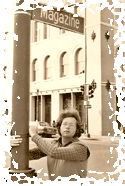Terra Verde
This article was originally printed in the April 1996 Sacramento Ragtime Society newsletter.
Though "New Ragtime" may provide an adequate reference for most of the music produced by self-described ragtime composers over the past twenty years, many significant compositions closely associated with the term stand outside any boundaries it may safely claim. That a number of the authors of these pieces see themselves as participants in the new World Piano spectrum (a domain as inclusive of Gottschalk, Nazareth, and Juan Morel Campos as Classic Ragtime) is only partly responsible for the eclecticism exceeding the confines of ragtime. New views of Romantic and salon piano music as well as the influence of hymns, traditional Anglo-Celtic and bluegrass music and Old World sources such as the French musette have also fed the new not-quite ragtime. By 1995 the quality and quantity of this music demanded that it be granted its own point of reference, a name independent of the word "ragtime" and its popular associations.
The term I've adopted in conjunction with my colleagues Scott Kirby and Frank French is Terra Verde, Latin for "green earth". The name is not offered as a precursor of academic definition (I, for one, hope that may be eluded) but as an elastic umbrella for recurrent directions and the well-linked sensibilities of the genre's practitioners. Not only does it fill a cultural niche; it liberates us from the disheartening baggage that the word "ragtime" has not been able to discard despite much impassioned effort over the years. With Terra Verde establishing the context, no listener will be able to prejudge such profound works as Kirby's Ravenna or St. Paris Pike or Hal Isbitz's The Flirt as less than the major examples of art music that they are.
I envision two immediate musical uses of the term "Terra Verde". The first is to identify that corpus of ragtime-related, frequently Latinesque contemporary music standing outside any established category. Examples of such "pure Terra Verde" are Kirby's Nocturnes, Belasco, and Ravenna; Isbitz's Morelia, The Flirt, and Mariposa; and my own To Nita, Maria Antonieta Pons, and much of New Orleans Streets. Frank French, long a champion of New World Piano, perhaps best represents his penchant for Terra Verde in Womba Bomba, dedicated to Kirby. Numerous Terra Verde pieces alternate ragtime (marching) bass patterns with "habanera" or other Latin ostinati (Kirby's Nocturne in C Sharp Minor, Isbitz's The Flirt, and my For Molly Kaufmann, which I once described as a "syncopated nocturne"). French's Intermezzo, though consistently employing a rag-like bass, vies for consideration as an example of Terra Verde cast as a piano rag (!)*. Glenn Jenks' Desdemona and Sousa possess Terra Verde characteristics, as do certain works of Jack Rummel and Brian Keenan.
The second application of the name under consideration is practical and temporal: to modify or subsume the term "New Ragtime" for purposes of presentation. While Terra Verde is not a subset of New Ragtime (though it in part grew out of it) New Ragtime may benefit from being treated as one of a family of directions flourishing under the Terra Verde aegis, much as various musics have been grouped under "ragtime". At the very least, New Ragtime can be bolstered by being offered as a companion genre. It is crucial that Terra Verde and New Ragtime composers at last gain the audience deserved by any serious music. In this quest the word "ragtime" must be handled carefully as all competent, concertizing ragtime artists have discovered. Couched in the arms of untainted and evolving Terra Verde, New Ragtime can grow beyond the clutches of the honky tonk-hatched spectres that continue to prey upon ragtime.
*This is reminiscent of the subtitle of Isbitz's Morelia, which itself might suggest the need to acknowledge a new genre: "Fantasy in the Form of a Tango".

